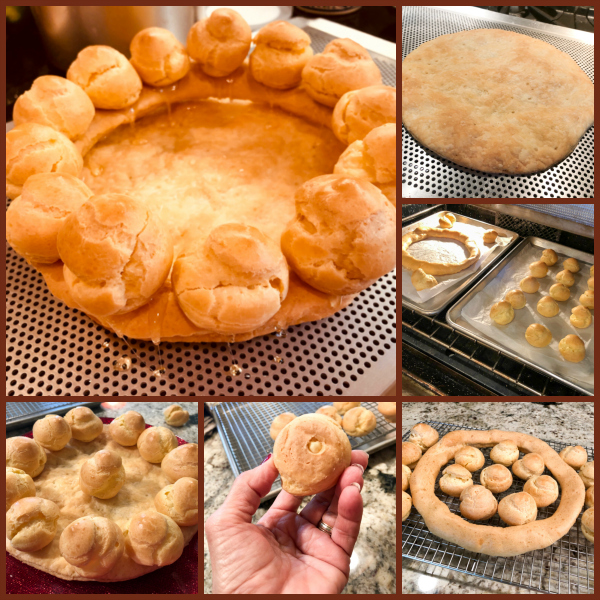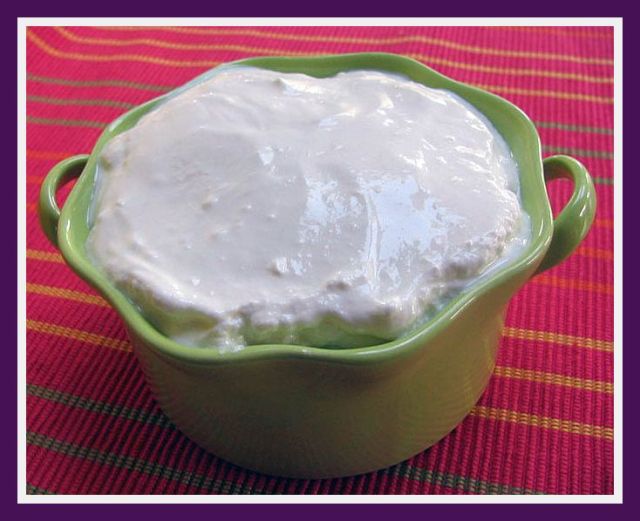Ten years. I have a hard time even finding what to say. It is true that I tend to stick with routines, but I’m a bit surprised not only that I’ve reached the 10 year mark, but that I still love food blogging. More now than ever, actually. My interest in baking has a lot to do with it, obviously, but it goes beyond that. I like the feeling of having formed a community of readers, many of them food bloggers also, who always cheer me up with comments, feedback and inspiration. Ten years. More than 1,200 posts. It blows my little mind. To celebrate the occasion, a cake is obviously needed. It had to be special. I chose a cake I’ve been in love with for my whole life, but felt a bit intimidated until now to make it from scratch. Gateau Saint-Honore, a true classic in French patisserie. Light it is not, but festive? Festive is its middle name.
GATEAU SAINT-HONORE
(from Helen Fletcher’s Pastries like a Pro)
Lightened Pastry Cream
2 teaspoon gelatin
1 + 1/2 tablespoons cold water
2 + 2/3 cup milk, hot
8 egg yolks
1 cup sugar (200 grams)
6 tablespoons flour (60 grams)
2 teaspoons vanilla extract
1 cup heavy cream
Soften the gelatin in the water and set aside. Whisk the egg yolks and sugar together in a non-reactive saucepan. Whisk in the flour. Add the milk slowly, whisking well and scraping the corners of pan with a rubber spatula to make sure all of the egg yolk mixture is incorporated.
Place over medium heat and, stirring constantly, bring to a boil. Boil for 1 minute, stirring constantly. Remove from the heat and add the vanilla. Tear the gelatin into small pieces and stir it into the hot liquid (there is no need to liquefy it, the heat of the mixture will do this for you). Pour into a storage container, cover the surface with plastic wrap, poke a few holes in it and refrigerate overnight to chill.
Slightly whisk the pastry cream to soften it. Whip the cream to stiff peaks. Fold into the pastry cream. The mixture is ready to pipe.
Basic Choux Pastry
1/2 cup water
4 tablespoons butter (60 grams)
1/4 teaspoon salt
3/4 cup sifted bread flour (100 grams)
3 whole eggs
1 + 1/2 tablespoons beaten egg (about half of a beaten egg)
Heat the oven to 400 degrees. Prepare two baking sheets with parchment paper. Draw a 10 inch circle on one piece of parchment. Set aside.
Combine the water, butter and salt in a small, heavy saucepan. Heat until the butter is melted and bring to a rapid boil. Add all the flour at once and stir rapidly until a large ball of dough forms that cleans the bottom and sides of the pan.With the pan still over heat, mash and flatten the panade with a spoon against the bottom of the pan.
Stir, bringing the bottom of the mixture to the top. Continue turning the panade and mashing it for 1 full minute. Remove the mixture from the heat and flatten it again in the bottom of the pan. Cool for 5 minutes. Place the panade in a food processor or the bowl of a mixer fitted with a paddle. Add the eggs and beaten egg. Process or mix until completely blended and a smooth paste forms.
At this point, gently wad up the parchment and soak in warm water for 5 to 7 minutes. When finished, gently shake off some of the water, but not all of it. Place on the baking sheet. Fit a pastry bag with a #8 plain tip and fill the bag with the choux paste. Pipe the choux paste on the inside of the circle. With the remaining paste pipe 20 walnut size puffs onto the second baking sheet after soaking it also. With a wet finger, lightly press down the pointy tops so they are round.
Bake for 25 minutes or until a deep golden brown. Cool completely.
Pate Brisee
3/4 cup sifted all-purpose flour (85 grams)
1/3 cup sifted cake flour (35 grams)
1/2 teaspoon salt
7 tablespoons butter, cut in small pieces and refrigerated (105 grams)
2 tablespoon beaten egg
1 teasoon lemon juice
2 tablespoons ice water
Heat oven to 375 degrees. Line a baking sheet with parchment paper.
In a processor bowl fitted with the steel blade, combine the flours and salt; process briefly to mix. Add the butter and place in a circle over the flours. Pulse until the butter is cut into large pieces.
Mix the egg, lemon juice and ice water. Pour over the flour/butter mixtureand pulse until it lumps together in its about the size of peas. Do not over-procress and especially don’t let it form a ball. Pour it out onto a work surface lightly dusted lightly with flour and push together into a ball. Form into a thick disc.
Wrap in plastic wrap and refrigerate for at least 30 minutes before rolling. Roll into a round about 11 inches. Trim the dough into a 10 1/2 inch round. Place on a parchment lined baking sheet, dock with a fork and refigerate about 30 minutes or until it is firm. Bake for 20 to 25 minutes until golden, firm and crisp. Cool completely.
Assembling the cake.
Place the pate brisee base on a 10 inch round. Set aside. Fit a pastry bag with a #2 plain tip. Make a hole in the bottom of each puff with a toothpick or cake tester. Enlarge it so the pastry tip will fit inside the puff. Fill the bag with pastry cream and pipe the cream into the puffs. Clean the bottom off so no cream oozes out. Set aside. Reserve the remaining pastry cream.
Make the caramel below.
Caramel
1/2 cup water
2 cups sugar
Place the water in a small saucepan. Add the sugar. Bring to a boil. Wash down the sides of the pan with a brush dipped in cold water. Boil the syrup hard until it just starts to color. At this point you must work quickly. The syrup will continue to color as you work. With a spoon dipped in the hot caramel, drizzle caramel around the edges of the pate.
Quickly place the choux paste ring on top of the base. Working quickly and carefully, dip the bottom of the small puffs in the caramel and attach them to the top of the choux ring. Quickly and very, very carefully dip the bottom of a small puff in the caramel and place it on the ring. Continue until the ring is covered with puffs.
Finishing the Gateau St. Honore
1/4 cup water
1 cup sugar
Place in a small saucepan. Prepare as above for the Caramel. However, this time take it to a dark amber. Cool for 30 to 40 second and Immediately spoon it over the puffs.
Fill the inside of the ring halfway up with pastry cream.Fit a pastry bag with a #8 open star tip and fill with the remaining pastry cream. Pipe large swirls over the pastry cream. Refrigerate for a few hours before serving.
ENJOY!
to print the recipe, click here
Comments: I wanted to use a tried and true recipe from an author I trust. Helen Fletcher’s recipes never disappoint me. Keep in mind that there are quite a few variations of this amazing gateau. For starters, the base can be either laminated dough or a pate brisee. The former is obviously a lot more involved, and the method changes also, because when using laminated dough the whole thing is baked together at the same time – the ring and usually additional inner circles (think of them as a maize) piped over the base. They add a bit more pastry component under the creamy topping. When using pate brisee, the ring is baked separately and later “glued” to the base with caramel. For my first attempt, I opted for pate brisee. I made it in a particular weekend in which I went into crazy baking mode. It was… intense to say the least. So pate brisee it was.
The traditional cream is a Chibouste, patisserie cream lightened up with what is essentially a meringue. That was how the cake was designed back in 1847 in the bakery at Rue St Honore in Paris. I used whipped cream, following Helen’s recipe. It is – if you can believe it – a bit richer. But a 10th blog anniversary does not come often. You do need something to lighten up the patisserie cream, otherwise the dessert would feel quite heavy and dense. Plus, you cannot really pipe “cream pat” (yeap, we are besties).
It is now full disclosure time. If you’ve been around my blog for a while, you should know that rarely patisserie stuff goes in smooth-mode with Sally. Take a look at the central choux puff. It is bald. I had saved the sexiest of them all for the center stage, and of course that was the one who did not get the final caramel glaze. I howled in shock when I noticed. But having been through a few ordeals with the preparation of the caramel, I could not bring myself to make more to coat just that one. Plus, I thought that some spun sugar carefully placed all over it would look nice and hide its nakedness. Spun sugar. Do you see ANY spun sugar on my gateau? No you do not. (pause to sob). I tried. I tried four times. I followed youtube instructions, I used thermometers, I burned fingers. The only thing spun was my brain. The mess in the kitchen? Unreal. I managed to come up with some abstract caramel thingie to stab on decorate the naked puff, and pretended that was my intention from the beginning. So I now desperately need to conquer the spun. I lose battles. But I refuse to lose the war.
Decoration messed up or not, it did not matter. The picture below shows all that was left from the cake by the time a get-together for some Tesla-afficcionados was over. The cake was delicious, even if I say so myself. It is of course, very rich, but it feels light and airy, not sure how that is even possible, having witnessed the amount of eggs, butter, and sugar involved. Let’s call it a French Miracle.
And now for the giveaway… It is a wonderful book that I believe will have even patisserie-phobes grabbing a whisk and marching to the kitchen with a big confident smile. The title says it all: Patisserie Made Simple. And it delivers what it promises.
I love this book, and if you would like a copy, I will enter you in the giveaway if you leave a comment. No matter where you live, I will ship it to you if you win it. I will reveal the winner on June 30th.
I want to thank all who enjoy hanging out here in this virtual spot, and invite you to follow with me as I start my second decade of food blogging. Ten years… oh, my!
ONE YEAR AGO: The Bewitching Kitchen turns 9!
TWO YEAR AGO: The Bewitching Kitchen turns eight!
THREE YEARS AGO: The Bewitching Kitchen Turns Seven!
FOUR YEARS AGO: Bewitching Kitchen Turns Six!
FIVE YEARS AGO: The Bewitching Kitchen turns Five!
SIX YEARS AGO: The Bewitching Kitchen turns Four!
SEVEN YEARS AGO: The Bewitching Kitchen Turns Three!
EIGHT YEARS AGO: The Bewitching Kitchen turns Two!
NINE YEARS AGO: Bewitching Birthday!
TEN YEARS AGO: Welcome to my blog!


























